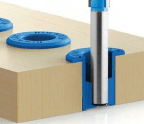Contemporary Hall Table

Tables like this one can go by several names: hall table, a console table or a sofa table. Well, po-tay-to, po-tah-to; to-may-to, to-mah-to; it doesn’t really matter what you call it — I’m going with “hall table,” since I’m putting it in the hall. Overall, it just matters that it looks good. Plus, it’s a nice exercise in basic woodworking.
I chose to make my table out of walnut. After cutting my walnut lumber into manageable sized chunks, my first building task was to work on the legs. I ripped a board of walnut into two pieces, each of which could yield two legs for this pretty standard style of four-legged table. I first crosscut the boards to the legs’ finished length of 29 ⁄ 8" on the table saw. I made these cuts with my miter gauge set to 5°, which is the angle of splay I wanted to maintain.


You might notice also that these legs are subtly tapered. I laid out my desired taper on the leg boards, marking lines that tapered from 2"
You’re reading a preview, subscribe to read more.
Start your free 30 days





